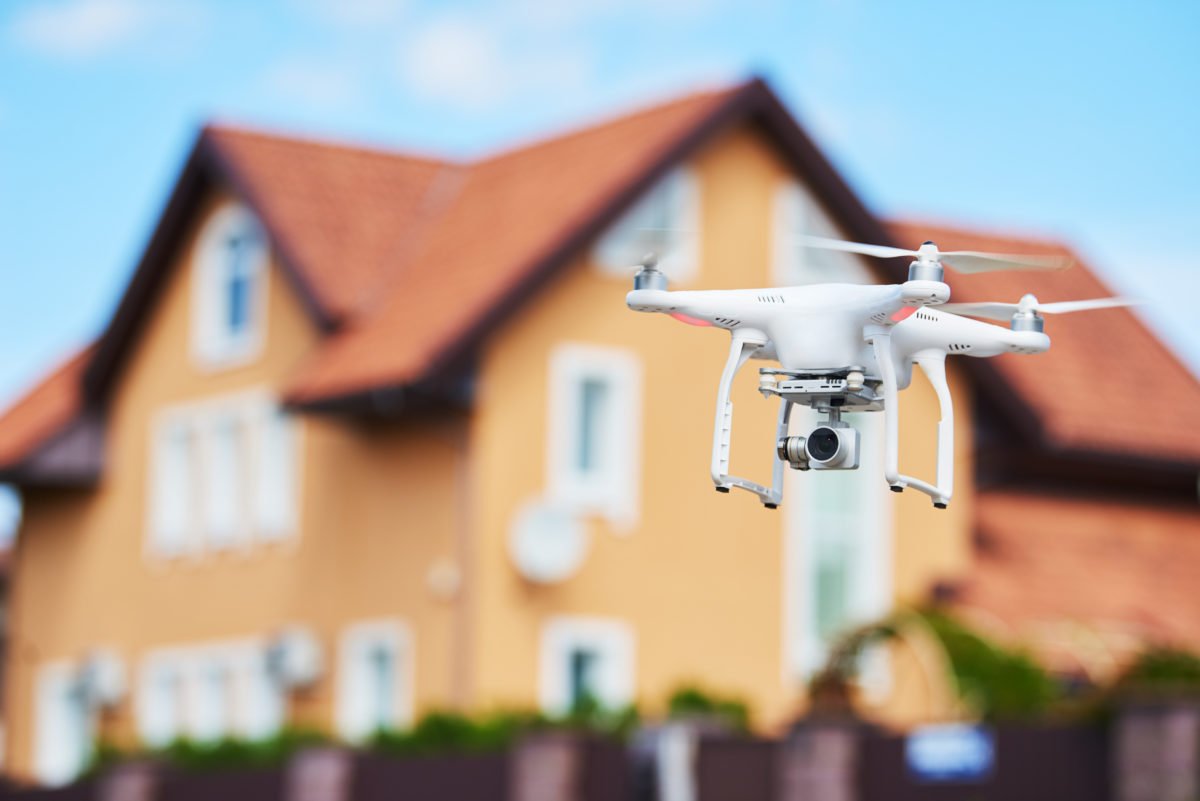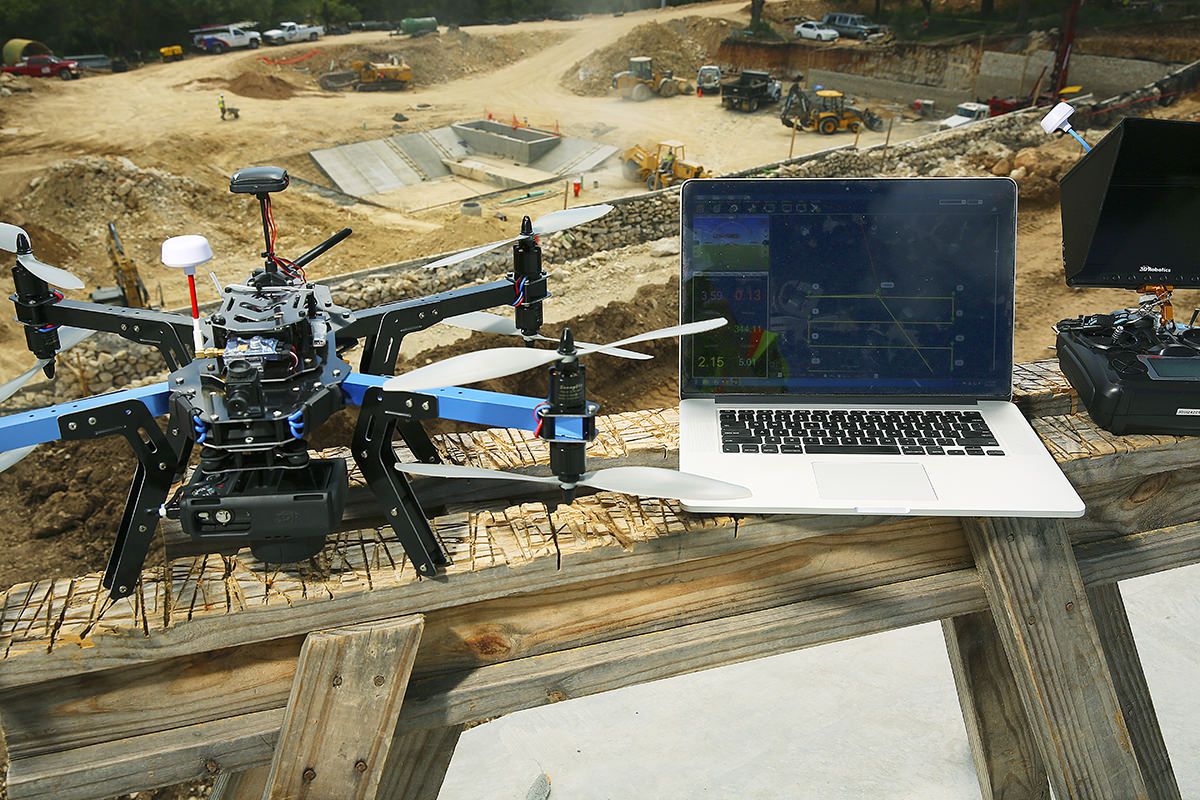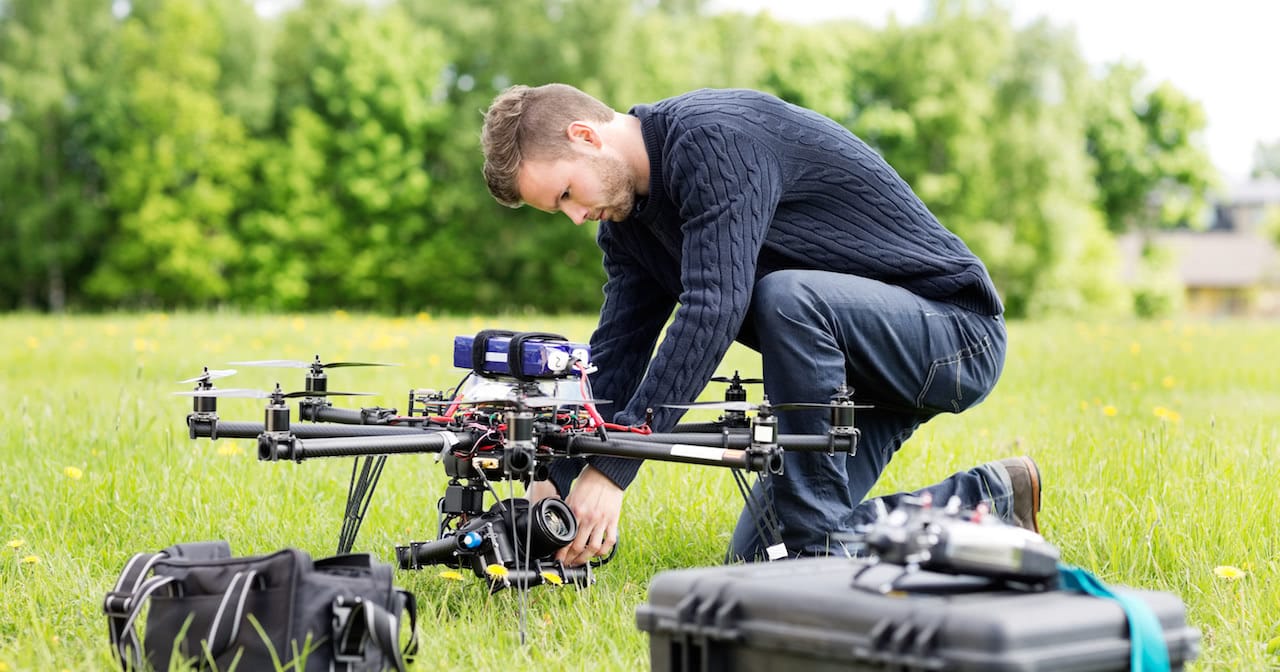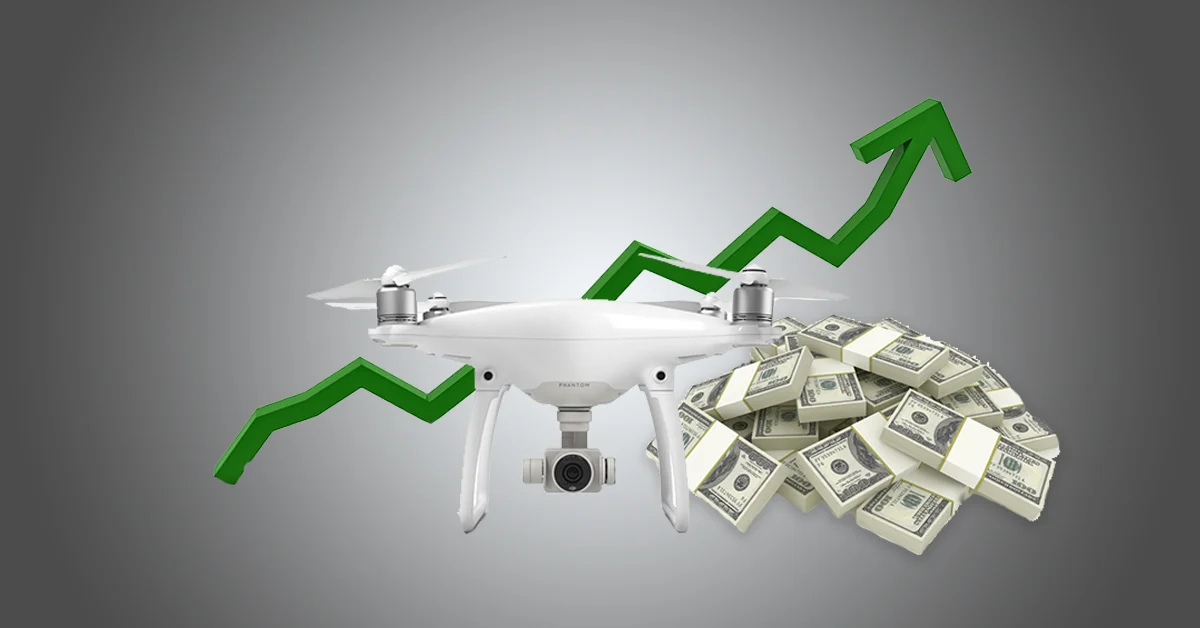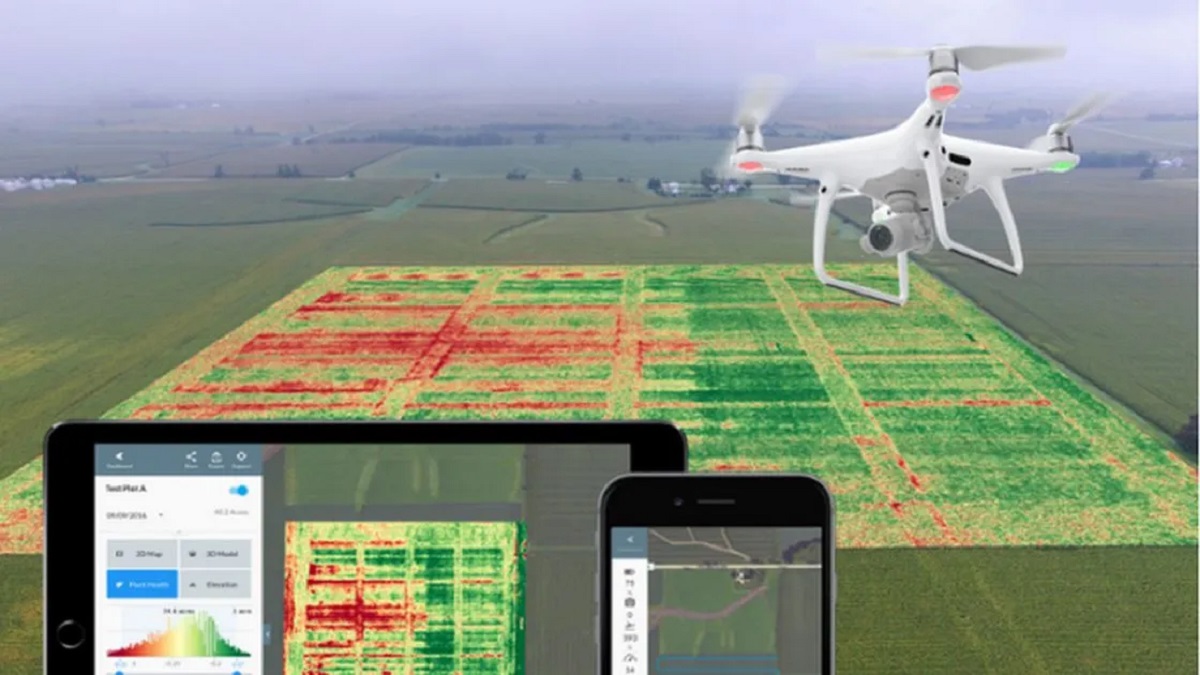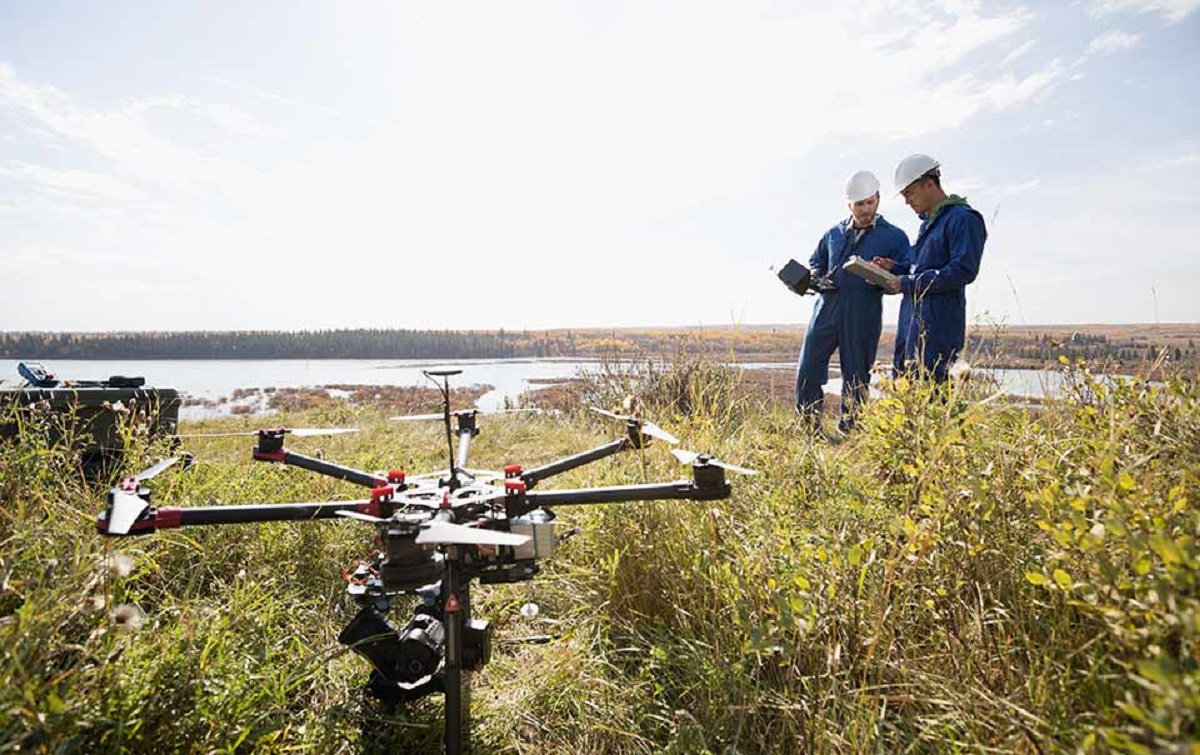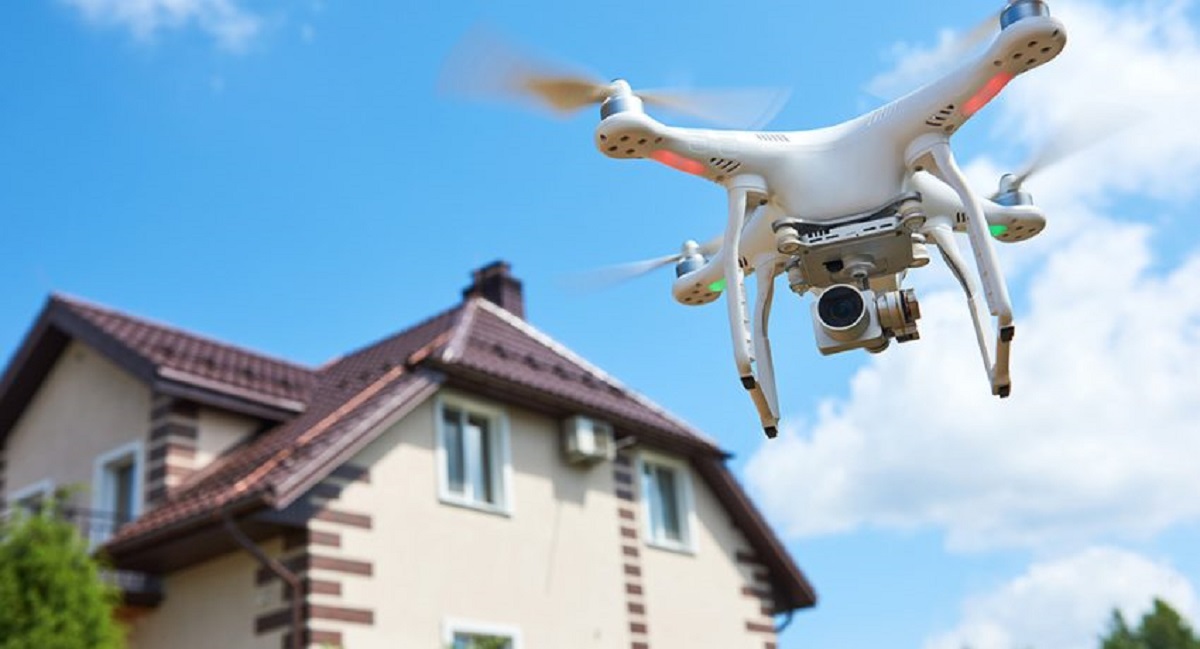Introduction
The drone industry has been experiencing a rapid growth in recent years, presenting a lucrative opportunity for entrepreneurs to start their own drone businesses. Drones, also known as unmanned aerial vehicles (UAVs), have revolutionized various sectors including photography, videography, agriculture, construction, real estate, and more.
In this article, we will explore the essential steps and considerations to start a successful drone business. Whether you are an experienced drone operator or a newcomer to the industry, this guide will provide you with valuable insights to launch and grow your own venture.
Starting a drone business requires careful planning and understanding of the industry’s landscape. It is crucial to conduct thorough market research to identify potential niches and customer needs. Additionally, legal and regulatory considerations must be taken into account to ensure compliance with local and federal laws.
Beyond the technical aspects, a solid business structure and financial planning are essential for long-term success. By developing a clear business plan and securing adequate financing, you can set a strong foundation for your drone business.
Building a professional drone fleet is a critical aspect of your business. Choosing the right drones that suit your target market and adding necessary accessories and equipment will enable you to provide high-quality services to your clients.
Obtaining the necessary licenses and certifications is vital for operating legally. Depending on your country and the services you offer, you may need to acquire pilot certifications, operation licenses, or permits.
Effectively marketing your drone business and creating a strong brand presence are essential for acquiring clients and standing out in a competitive industry. Developing strategic partnerships with relevant businesses can also help to expand your customer base and increase your market reach.
Furthermore, efficient operations management, exceptional customer service, and mindful insurance and risk management strategies are key elements in running a successful drone business. As your business grows, scalability and growth strategies become important to capitalize on market opportunities.
Understanding the Drone Industry
The drone industry is a dynamic and constantly evolving field that offers a wide range of opportunities for entrepreneurs. Before diving into starting a drone business, it is essential to gain a comprehensive understanding of the industry and its potential.
One of the key factors driving the growth of the drone industry is the versatility of drones and their applicability across various sectors. Drones have disrupted traditional methods of data collection and have proven to be highly efficient and effective in tasks such as aerial photography, videography, surveying, mapping, and inspections.
The real estate industry has embraced drones for capturing stunning aerial footage of properties, enabling a unique and captivating perspective for potential buyers. Construction companies utilize drones for surveying and monitoring construction sites, enabling them to detect and address issues promptly.
Agriculture is another sector where drones have made significant advancements. With the ability to collect data on crop health, monitor irrigation systems, and even spray fertilizers, drones have become valuable tools for farmers to optimize their processes and improve yields.
The entertainment industry has also benefitted greatly from the use of drones. Movies and TV shows utilize drones for breathtaking aerial shots, offering a cost-effective alternative to helicopters or cranes.
Understanding the competitive landscape of the drone industry is crucial when starting a drone business. Research competitors in your area and identify their strengths and weaknesses. Assessing the services they offer, their pricing, and their target markets will help you differentiate your business and carve out a unique selling proposition.
Furthermore, keep a close eye on technological advancements in the drone industry. Innovations such as obstacle avoidance systems, longer flight times, and improved camera capabilities can give your business a competitive edge. Stay up to date with industry trends and continuously adapt your services to meet the evolving needs of your target customers.
In summary, the drone industry offers a vast range of opportunities across various sectors. By understanding the versatility of drones and staying informed about market trends and technological advancements, you can position your drone business for success.
Market Research and Analysis
Market research is a crucial step in launching a drone business. It helps you understand your target market, assess competition, and identify untapped opportunities. By conducting thorough market research and analysis, you can make informed decisions and develop strategies that align with market demands.
Start by identifying the specific industries or sectors you plan to target with your drone services. Consider the potential clients in these industries and their unique needs. For example, if you plan to offer aerial photography services, research the demand for such services in real estate, wedding and event planning, and tourism sectors.
Study your potential competitors operating in your target market. Analyze the services they offer, their pricing, marketing strategies, and reputation. Identify gaps or areas where you can differentiate your business. This could be through specialized services, competitive pricing, or exceptional customer service.
Moreover, analyze the demographic and geographic factors that can influence the demand for your drone services. Identify areas with untapped potential or regions where the competition is relatively low. This can help you position your business strategically and focus your marketing efforts.
Another important aspect of market research is understanding the regulatory landscape. Different countries and regions have different rules and regulations governing drone operations. Familiarize yourself with the local laws and ensure that you can legally operate your drone business within those boundaries.
Market analysis involves studying trends and projections in the drone industry. Stay updated with industry publications, reports, and forums to comprehend the current state of the market and its growth potential. This information will help you make informed decisions about the viability and potential profitability of your drone business.
During your research, gather data on potential clients, market size, competition, and any other relevant factors. This information will be invaluable when developing your business plan and marketing strategies. Use surveys, interviews, and online research tools to gather accurate and up-to-date market data.
Remember, market research is an ongoing process. As your drone business grows and the industry evolves, continue to analyze the market to identify new opportunities and stay ahead of the competition.
Legal and Regulatory Considerations
When starting a drone business, it is crucial to understand and comply with the legal and regulatory requirements governing drone operations. Failure to do so can result in fines, legal issues, and damage to your business reputation. Therefore, familiarize yourself with the following key considerations to ensure lawful and safe operations.
First and foremost, check the drone regulations specific to your country or region. These regulations can vary greatly, so it is essential to be well-versed in the rules that govern your operations. Understand the restrictions on flight altitude, flight zones (such as near airports or government buildings), and time limitations.
Many countries require drone operators to obtain a license or permit to operate commercially. Research the specific requirements and determine if you need to complete a training program or pass an exam to obtain the necessary certification. Compliance with these requirements is crucial for the legality of your operations and to ensure the safety of yourself and others.
Additionally, familiarize yourself with privacy and data protection laws. Drones equipped with cameras have the potential to capture sensitive information or invade individuals’ privacy. Ensure that you comply with applicable laws and obtain consent when necessary. Safeguard any personal or confidential data collected during your operations.
Insurance coverage is another important consideration. Protect yourself and your business from potential liability by obtaining appropriate insurance coverage for your drone operations. This can include liability insurance, hull insurance for your drone, and even loss of income coverage in case of accidents or equipment failure.
It is crucial to have a strong understanding of airspace regulations and restrictions. Ensure that you are aware of any temporary or permanent flight restrictions in the areas you plan to operate. This is especially important when operating near airports, military bases, or other sensitive areas.
Staying up to date with changes in regulations is vital as the drone industry rapidly evolves. Subscribe to industry newsletters, join relevant associations, and participate in forums to remain informed about any changes or updates to drone laws. This will help you adapt your operations and ensure compliance.
To summarize, compliance with legal and regulatory requirements is a fundamental aspect of operating a drone business. Stay informed about the specific rules and regulations in your country or region, obtain necessary licenses and certifications, maintain proper insurance coverage, and always prioritize safety and privacy considerations in your operations.
Business Structure and Planning
Establishing a solid business structure and plan is essential for the success of your drone business. Proper planning will help you identify your goals, set a clear direction, and outline the necessary steps to achieve them.
The first step is to determine the legal structure of your business. Common options include a sole proprietorship, partnership, limited liability company (LLC), or corporation. Each structure has its advantages and disadvantages, so it’s important to choose the one that aligns with your long-term goals, tax liabilities, and potential growth plans.
Next, create a detailed business plan that outlines your services, target market, marketing strategies, financial projections, and growth plans. A well-crafted business plan serves as a roadmap for your business and helps you stay focused on your objectives. It also becomes a valuable tool when seeking financing or partnerships.
Identify your target market and develop a clear understanding of their needs and expectations. Determine how your drone services can address those needs in a unique and compelling way. Conduct market research to validate your assumptions and refine your offerings accordingly.
Define your pricing strategy based on factors such as the market demand, competition, and cost of operations. Consider offering different packages or tiered pricing to cater to various client budgets and requirements. Striking the right balance between affordability and profitability is crucial in the early stages of your drone business.
Explore financing options available to you, especially if you require funding to purchase equipment, develop your website, or market your services. Consider traditional loans, crowdfunding, or seeking investors who believe in your business concept and long-term potential.
Develop a comprehensive marketing plan to promote your drone services. Identify the most effective channels to reach your target market, whether it’s through social media, online advertising, attending industry events, or partnering with complementary businesses. Build a strong online presence through a professional website, blog, and active social media accounts.
Establish a workflow and operational structure that ensures efficient service delivery. Determine how you will handle inquiries, bookings, and scheduling. Develop standard operating procedures to maintain consistency in your operations and customer interactions.
Finally, regularly evaluate and update your business plan as your drone business grows and evolves. Assess the effectiveness of your strategies, review financial performance, and adjust your goals and targets accordingly. Being adaptable and agile is key to staying competitive in the dynamic drone industry.
Remember, a well-structured and thought-out business plan sets the stage for long-term success. It helps you stay focused, make informed decisions, and effectively navigate the challenges and opportunities that come with running a drone business.
Financing the Drone Business
Securing adequate financing is a critical aspect of starting and growing a drone business. Whether you are looking to purchase equipment, develop your website, or invest in marketing efforts, having access to sufficient funds is essential. Here are some financing options to consider when launching your drone business.
One option is to use personal savings or personal loans. This allows you to fund your business using your own resources or borrowing from friends or family. While this can provide a quick and flexible financing solution, it is important to carefully consider the risks and potential strain on personal relationships.
Traditional business loans from banks and financial institutions are another avenue to explore. Prepare a comprehensive business plan and financial projections to present to potential lenders. Having a solid plan demonstrates your commitment and increases your chances of securing a loan at a favorable interest rate.
Crowdfunding platforms offer an alternative way to raise funds for your drone business. Create a compelling campaign that communicates your business concept and the value you bring to customers. This approach allows you to tap into a larger network of potential supporters who believe in your vision and are willing to contribute financially.
Seeking investors is another option, particularly if you have a scalable business model with high growth potential. Pitch your business idea to angel investors or venture capitalists who specialize in the drone industry. Be prepared with a detailed presentation and financial projections that highlight the return on investment they can expect.
In some countries, government grants or subsidies are available for businesses involved in innovative industries like drones. Research and identify relevant programs that can provide financial support or access to industry-specific resources. This can help offset startup costs and accelerate your drone business’s growth.
Consider leasing or financing options for your drone equipment. This can help reduce the upfront costs and allow you to invest in high-quality equipment without significant capital expenditure. Lease-to-own agreements or financing plans spread the cost over time, enabling you to generate revenue while paying off the equipment.
Finally, explore partnerships or strategic alliances with companies that can provide financial backing or support your business in other ways. This could include partnering with established drone operators, photography studios, or aerial service providers that can offer resources, expertise, or a client base to kickstart your business.
Remember, financing is a crucial aspect of starting and growing a drone business. Evaluate your options, weigh the pros and cons of each, and make informed decisions that align with your long-term goals. With the right financing strategy, you can secure the necessary funds to launch and scale your drone business effectively.
Building a Professional Drone Fleet
Building a professional drone fleet is a critical aspect of establishing a successful drone business. The quality and capabilities of your drones will directly impact the services you can offer and the satisfaction of your clients. Here are some important considerations when building your drone fleet.
Start by assessing your business needs and the specific services you plan to offer. This will help you determine the types of drones and accessories that are most suitable for your operations. Consider factors such as flight time, payload capacity, camera quality, obstacle avoidance capabilities, and durability.
Research and compare different drone models on the market. Read reviews, watch demonstration videos, and consult experts or other drone operators for their recommendations. Look for drones that provide the best balance of performance, reliability, and value for money.
It is often beneficial to have a range of drones with varying features and capabilities to cater to different client needs. For example, have a drone for aerial photography and videography, one for thermal inspections, and another for agricultural surveys. This flexibility allows you to diversify your services and attract a wider range of clients.
Ensure that your drones are equipped with necessary accessories such as extra batteries, memory cards, propellers, and carrying cases. Having spare parts and accessories readily available not only enables you to handle unforeseen situations but also demonstrates your professionalism and commitment to delivering high-quality services.
Invest in drone training for yourself and your team. Acquiring the necessary skills and knowledge to safely operate drones is essential to avoid accidents and ensure compliance with regulations. Training programs can cover topics such as flight maneuvers, emergency procedures, photography and videography techniques, and maintenance.
Consider the long-term maintenance and repair requirements of your drone fleet. Check if the manufacturer offers warranty and after-sales support, and if there are authorized service centers available in your area. Regularly perform maintenance checks and keep all software and firmware up to date to ensure optimal performance.
Insurance coverage for your drone fleet is crucial. Accidents can happen, and having comprehensive insurance coverage will protect your business from potential liabilities. Research insurance providers that specialize in drone coverage and select a policy that suits your specific needs and risk profile.
Expanding your drone fleet as your business grows is a natural progression. Continuously evaluate the performance and effectiveness of your drones and upgrade or add new models as needed. Stay informed about advancements in drone technology to ensure you are offering the latest capabilities to your clients.
Remember, your drone fleet is the backbone of your business. Investing in high-quality drones, accessories, and training will not only enhance your service offerings but also help build a strong reputation as a professional drone operator.
Acquiring the Necessary Licenses and Certifications
Acquiring the necessary licenses and certifications is a crucial step in operating a drone business legally and safely. Compliance with local regulations and requirements is essential to avoid penalties and ensure the professionalism of your services. Here are key considerations when obtaining licenses and certifications for your drone business.
First and foremost, research the specific regulations and licensing requirements that apply to drone operations in your country or region. Different jurisdictions may have varying rules, so it is crucial to understand the specific rules that govern your operations. Familiarize yourself with drone flight restrictions, altitude limits, and any specific licensing categories or classes.
In many countries, drone operators are required to obtain certifications or licenses to operate commercially. These certifications may involve passing a written exam and, in some cases, a practical flight test. The certification process aims to ensure that operators have the necessary knowledge and skills to operate drones safely and responsibly.
Consider joining professional associations or organizations related to the drone industry. These associations often provide additional training, resources, and certification programs to enhance your skills and demonstrate your commitment to professionalism. Having certifications from recognized industry organizations can add credibility to your drone business.
Depending on local regulations, you may also need to obtain special permits or licenses for specific types of drone operations. For example, if you plan to conduct night flights or operate in restricted areas, you may need to apply for additional permits. Research any additional requirements related to your intended operations and ensure that you comply with them.
Maintaining compliance with licensing and certification requirements is an ongoing process. Stay informed about any updates or changes in regulations. Attend workshops, conferences, and webinars to stay up to date with the latest industry developments, best practices, and changes in local laws.
Furthermore, consider obtaining liability insurance coverage for your drone operations. Accidents or damages can occur despite your best efforts to operate safely. Insurance coverage protects you and your business from potential financial liabilities and ensures that you are prepared for any unforeseen events.
Remember that acquiring the necessary licenses and certifications demonstrates your commitment to legal and safe drone operations. It builds trust with clients and differentiates you from operators who may not meet the required standards. Stay informed, comply with regulations, and continuously update your skills and knowledge to maintain a professional and successful drone business.
Marketing and Branding Strategies
Effective marketing and branding are essential components of a successful drone business. They help you attract clients, differentiate yourself from competitors, and establish a strong reputation in the industry. Here are some key strategies to consider when marketing and branding your drone business.
Start by identifying your target market and understanding their needs and preferences. Develop a customer persona that represents your ideal client, including demographics, characteristics, and pain points. This will help you tailor your marketing messages and strategies to attract your target audience.
Create a professional and visually appealing website that showcases your services, portfolio, and contact information. Your website should be easy to navigate, mobile-friendly, and optimized for search engines. Include high-quality images and videos to demonstrate the quality of your work and engage potential clients.
Utilize social media platforms to promote your drone services and connect with your target audience. Establish an active presence on platforms like Instagram, Facebook, LinkedIn, and YouTube. Share eye-catching visuals, behind-the-scenes videos, client testimonials, and insightful tips to engage with your audience and build credibility.
Develop a compelling brand identity that reflects the values and unique selling proposition of your drone business. Design a logo, choose a color palette, and create a consistent visual theme across your marketing materials. Your brand identity should convey professionalism, innovation, and reliability.
Consider partnering with complementary businesses to expand your reach and client base. Identify industries or sectors that can benefit from drone services and establish partnerships with real estate agents, event planners, construction companies, and more. Cross-promoting each other’s services can lead to mutually beneficial collaborations.
Attend industry conferences, trade shows, and networking events to connect with potential clients and industry professionals. Be prepared with marketing materials such as business cards, brochures, and promotional giveaways to leave a lasting impression.
Optimize your online presence by implementing search engine optimization (SEO) strategies. Research relevant keywords and incorporate them into your website content, blog posts, and social media captions. This will improve your visibility in search engine results and attract organic traffic to your website.
Build your credibility and reputation by sharing client testimonials and case studies. Highlight successful projects you have completed and showcase the positive results achieved for your clients. Word-of-mouth referrals and positive reviews are powerful marketing tools in the drone industry.
Consider offering special promotions or discounts to attract new clients and encourage repeat business. Offering package deals or referral incentives can help incentivize clients to choose your services over competitors.
Lastly, provide exceptional customer service to ensure client satisfaction and encourage positive word-of-mouth. Respond promptly to inquiries, be professional and courteous in all interactions, and deliver services that exceed client expectations. Happy clients are more likely to refer your services to their network.
Remember that effective marketing and branding strategies require consistent effort and adaptation. Stay updated with industry trends, monitor the performance of your marketing campaigns, and continuously refine your strategies to maximize your visibility and attract your target audience.
Pricing and Profitability Analysis
Setting the right pricing structure is crucial for the success and profitability of your drone business. Pricing your services competitively while ensuring adequate profitability requires careful analysis and consideration of various factors. Here are some key strategies for pricing your drone services and conducting a profitability analysis.
Start by understanding your cost structure. Calculate all the costs associated with operating your drone business, including equipment, maintenance, insurance, training, marketing, and overhead expenses. This will give you a clear understanding of the minimum price you need to charge to cover your costs and achieve profitability.
Consider the value you provide to your clients and the quality of your services. If you offer specialized skills, advanced technology, or unique expertise, you may be able to command a higher price compared to competitors. Highlight the benefits and advantages of choosing your services to justify your pricing.
Analyze your target market and understand the price sensitivity of your potential clients. Research the prices charged by competitors in your area and assess the value they offer. This will help you position your services competitively while maintaining profitability.
Offer different pricing packages to cater to different client needs and budgets. Create tiered pricing structures that include different levels of service, ranging from basic to premium offerings. This will allow you to target a wider range of clients and capture different segments of the market.
Consider the duration and complexity of each project when determining your pricing. Some projects may require additional time for planning, setup, and post-processing, which should be factored into your prices. Be transparent with clients about any additional costs involved to ensure clear communication.
Utilize cost-plus pricing or value-based pricing methods to set your prices. Cost-plus pricing involves adding a markup to your costs to determine the selling price. Value-based pricing, on the other hand, considers the perceived value of your services to clients and prices accordingly.
Regularly review and adjust your pricing strategy to stay competitive and profitable. Analyze your profitability by monitoring your revenue, costs, and profit margins. Identify trends and patterns in your pricing data to make informed decisions about pricing adjustments or promotions.
Consider incorporating upselling and cross-selling strategies to maximize your profitability. Offer complementary services or additional add-ons that can enhance the overall value for clients and increase your revenue. This can include services like aerial video editing, custom reports, or specialized data analysis.
Lastly, keep in mind that pricing is not solely about profitability. It is also about ensuring long-term sustainability and building strong client relationships. Providing high-quality services, excellent customer support, and value-added benefits can justify higher prices and contribute to repeat business and positive referrals.
Regularly analyze and evaluate your prices and profitability to ensure your drone business remains competitive, sustainable, and profitable. By effectively pricing your services, you can strike a balance between attracting clients and achieving your financial goals.
Identifying Target Customers
Identifying and understanding your target customers is essential for the success of your drone business. By clearly defining your ideal clients, you can tailor your marketing efforts, develop targeted messaging, and maximize your chances of attracting the right customers. Here are some strategies for identifying your target customers.
Start by conducting market research to understand the demand for drone services in different industries and sectors. Identify sectors that have a high potential for utilizing drone technology, such as real estate, agriculture, construction, or film and photography.
Segment your target market based on industry or specific use cases. For example, within the real estate industry, you may target real estate agents, property developers, or architects who can benefit from aerial photography and video services. This segmentation helps you better understand their specific needs and value propositions.
Consider the geographic location of your target customers. Assess the potential demand for drone services in different cities, regions, or even countries. Research local competition and market trends to determine the viability and potential saturation in specific locations.
Create detailed customer personas to represent your target customers. These personas should include demographic information, such as age, gender, income level, and occupation. Additionally, include psychographic information, such as interests, behaviors, and preferences that may influence their decision to hire drone services.
Study your competitors and the clients they serve. Identify any gaps or underserved segments within the market. Assess how you can differentiate and position your drone services to cater to those specific needs, whether it’s through specialized services, better pricing, or superior customer experience.
Gain insights from existing clients by conducting surveys or interviews. Understand why they chose your services, their expectations, and what value they find in your offerings. Use this feedback to refine your target customer profile and optimize your marketing strategies.
Consider the potential size and profitability of your target market segments. Evaluate the purchasing power and growth opportunities within each segment. This will help you prioritize your marketing efforts and allocate resources effectively.
Segment your target customers by their level of familiarity and understanding of drone technology. Some may be well-versed in the benefits of drones and require more advanced services, while others may require education and a more introductory approach. Tailor your messaging and offerings accordingly.
Finally, continuously evaluate and refine your target customer profile as your business evolves and the market changes. Stay updated with industry trends and technological advancements to identify new opportunities and adjust your target segment accordingly.
By identifying your target customers, you can tailor your marketing and business strategies to attract and serve the right audience. Understanding their needs, preferences, and behaviors will help you position your drone services effectively and nurture long-lasting client relationships.
Developing Strategic Partnerships
Developing strategic partnerships is a valuable strategy for growing and expanding your drone business. By forming alliances with complementary businesses or industry stakeholders, you can leverage their networks, expertise, and resources to enhance your service offerings and increase your market reach. Here are some key considerations when developing strategic partnerships for your drone business.
Identify the target businesses or organizations that align with your goals and can help you reach your target customers. Look for businesses that can benefit from integrating drone services into their operations or have a shared target market. This could include real estate agencies, construction companies, event planners, or environmental consulting firms.
Research potential partners to assess their reputation, values, and track record. Look for businesses with a strong presence in their industry and a demonstrated commitment to delivering high-quality services. Consider their market reach, client base, and market positioning to ensure a mutually beneficial partnership.
Approach potential partners with a clear value proposition and benefits that your drone services can bring to their business. Demonstrate how your services can enhance their offerings, improve operational efficiency, or provide a competitive edge. Emphasize the potential for collaboration and mutually beneficial growth.
Develop a win-win partnership agreement that outlines the roles, responsibilities, and benefits for both parties. Define the scope of the partnership and determine how you will co-market or refer clients to each other. Establish clear expectations, communication channels, and mechanisms for resolving conflicts or issues that may arise.
Create marketing collateral, such as brochures, case studies, or joint promotional materials, that highlight the value of the partnership to potential clients. Collaborate with your partners to develop content, organize webinars or events, or contribute to industry publications. Co-marketing efforts can help increase brand visibility and attract new clients.
Collaborate on value-added services or bundled offerings that incorporate your drone services and those of your partners. For example, if partnering with a real estate agency, you could offer a package that includes aerial photography and virtual tours alongside their property listings. This cross-promotion can benefit both parties and provide additional value to clients.
Regularly communicate and collaborate with your partners to ensure the partnership remains strong and mutually beneficial. Share industry insights, provide updates on your service offerings, and discuss ways to improve and expand the partnership. Long-term relationships built on trust and collaboration are more likely to lead to sustainable growth.
Monitor and evaluate the impact of your partnerships on your business growth and client acquisition. Track metrics such as the number of referrals, revenue generated through partnerships, and client satisfaction. Use this data to identify successful partnerships and make informed decisions on future collaborations.
Remember, strategic partnerships can provide significant growth opportunities for your drone business. Forge partnerships with businesses that share your values and target market, develop mutually beneficial agreements, and nurture strong relationships. Strategic partnerships can amplify your reach, enhance your service offerings, and contribute to the long-term success of your drone business.
Providing Exceptional Customer Service
Providing exceptional customer service is crucial for the success and reputation of your drone business. Happy and satisfied clients are more likely to become repeat customers and refer your services to others. Here are some strategies to ensure you deliver exceptional customer service.
First and foremost, prioritize responsiveness and prompt communication. Respond to inquiries and client requests as quickly as possible, demonstrating that their needs are a top priority. Clear and timely communication builds trust and shows your dedication to providing a positive customer experience.
Listen actively to your clients and understand their specific needs and expectations. Take the time to ask pertinent questions to ensure you have a thorough understanding of their project requirements. This allows you to tailor your services and provide personalized solutions.
Set clear expectations and manage client expectations throughout the entire process. Provide realistic timelines and delivery dates, so clients know what to expect and when they can anticipate the final results. Be transparent about any limitations or potential challenges that may arise during the project.
Strive for excellence in the quality of your work. Pay attention to detail and ensure that the deliverables meet or exceed client expectations. Take pride in delivering services of the highest caliber, whether it’s aerial photography, videography, or inspection services.
Establish open lines of communication and be readily available to address any questions or concerns that clients may have. Make it easy for them to reach out to you via phone, email, or through your website. Displaying excellent communication and availability builds confidence and trust in your services.
Show appreciation and gratitude towards your clients. Thank them for choosing your services and express your gratitude for their business. Follow up with a personalized message or a small token of appreciation after completing a project. This gesture goes a long way in fostering strong relationships.
Strive to continuously improve your skills and knowledge to provide the best possible service. Stay updated with the latest industry trends, new equipment, and software advancements. Adding value through additional training and expertise positions you as a trusted professional in your field.
Handle any concerns or complaints with a proactive and solution-oriented approach. Address issues promptly and professionally, taking the necessary steps to resolve them to the client’s satisfaction. A positive and responsive resolution can turn a dissatisfied client into a loyal advocate for your business.
Solicit feedback from your clients through surveys or follow-up emails. Listen to their opinions, suggestions, and areas for improvement. Use this feedback to refine your services, enhance the customer experience, and adapt to changing client expectations and demands.
Cultivate long-term relationships with your clients. Stay in touch after completing a project, send occasional updates or relevant resources, and consider offering incentives for repeat business or referrals. Building a loyal client base is essential for the sustainability and growth of your drone business.
Remember that exceptional customer service is a cornerstone of any successful business. Prioritize open communication, exceed expectations, and foster strong client relationships. By delivering exceptional customer service, you can build a solid reputation, foster client loyalty, and differentiate yourself from competitors in the drone industry.
Insurance and Risk Management
Insurance and risk management are vital aspects of running a drone business. Given the potential risks and liabilities associated with drone operations, having appropriate insurance coverage and effective risk management strategies in place is essential. Here are key considerations for insurance and risk management in your drone business.
Start by researching the different types of insurance coverage relevant to drone operations. Drone liability insurance is particularly important, as it provides financial protection in case of accidents, property damage, or bodily injury. Other types of insurance to consider include hull insurance to cover damage to your drones, personal injury coverage, and loss of income insurance.
Consult with a reputable insurance provider who specializes in drone insurance and understands the unique risks associated with your operations. They can guide you in selecting the right coverage options based on your specific needs. Make sure the policy covers the type of services you offer and aligns with local regulations.
Review and understand the terms and conditions of your insurance policy, including any limitations or exclusions. Ensure you comply with any safety protocols or requirements defined by the insurer. This may involve following specific flight guidelines, conducting regular equipment inspections, or maintaining documentation of your operating procedures.
Implement rigorous risk management practices to minimize the likelihood of accidents or incidents. Develop standard operating procedures, train your team on safety protocols, and prioritize preventive maintenance of your drones. Maintaining a safe work environment and adhering to all applicable laws and regulations are crucial for risk mitigation.
Consider implementing a pre-flight checklist to ensure the readiness and safety of your drones before each operation. This includes inspecting equipment, verifying battery levels, assessing weather conditions, and checking for any potential safety hazards. By following a checklist, you can significantly reduce the risk of equipment failure or other issues during flights.
Stay aware of changes in regulations and compliance requirements related to drone operations. Regularly review local laws, permit or licensing requirements, and any restrictions that may affect your operations. Noncompliance with regulations not only poses legal risks but may also void your insurance coverage.
Document all aspects of your operations, including flight plans, maintenance records, and client agreements. Accurate record-keeping is crucial for insurance claims and can help protect your business in case of disputes or legal issues. Store these records securely and have a system in place to easily retrieve them when necessary.
Regularly reassess your insurance coverage as your business evolves and your operations expand. As you add new services or equipment, update your insurance policies to ensure that you have adequate coverage. Seek guidance from your insurance provider to determine if adjustments or additions are necessary.
Lastly, establish a contingency plan to respond to emergencies or unexpected events. This includes having protocols in place for incident reporting, communication with clients or authorities, and taking appropriate action to address the situation swiftly and effectively.
Remember, insurance and risk management are crucial for protecting your business and ensuring the safety of your clients and the public. By securing appropriate insurance coverage, implementing risk management practices, and staying informed about regulations, you can mitigate risks and establish a solid foundation for the long-term success of your drone business.
Managing Operations Efficiently
Efficiently managing your operations is key to delivering high-quality drone services and ensuring the success of your business. By implementing effective operational strategies and streamlining your processes, you can enhance productivity, minimize costs, and maximize customer satisfaction. Here are some tips for managing your drone business operations efficiently.
Start by establishing clear workflows and processes for different stages of your operations, from project planning to post-processing and delivery. This includes outlining the steps, roles, and responsibilities for each stage. Standardized processes minimize errors, ensure consistency, and increase overall efficiency.
Invest in operational tools and technologies that can streamline your workflow. Utilize project management software to track assignments and deadlines, collaborate with team members, and manage client communication. Automated scheduling tools can help optimize the allocation of resources and ensure efficient utilization of time.
Implement a robust data management system to organize and store all project-related data, such as flight logs, images, and client information. Cloud-based storage solutions facilitate easy access, sharing, and backup of data, enhancing efficiency and data security.
Implement a maintenance and inventory management system to ensure that your drones and equipment are in optimal condition. Regularly inspect your fleet, perform necessary maintenance tasks, and keep an accurate inventory of spare parts and accessories. This minimizes downtime due to equipment failures and ensures smooth operations.
Optimize your flight planning by utilizing available tools and technologies. Use aerial mapping and modeling software to plan efficient flight paths and assess the coverage area. This allows you to optimize flight time, capture accurate data, and improve project turnaround times.
Ensure that your team is trained and knowledgeable on the latest drone technology, flight regulations, and industry best practices. Regularly provide training sessions to keep your team up to date with advancements and ensure compliance with changing regulations. Well-trained and competent team members contribute to efficient and safe operations.
Constantly monitor and evaluate your operational performance. Track key performance indicators (KPIs) such as project completion time, client satisfaction, and resource utilization. Analyze the data to identify areas for improvement and implement corrective actions to optimize efficiency.
Implement quality control measures to maintain consistently high standards in your deliverables. This may include implementing a review process to ensure the accuracy and quality of captured data, verifying the alignment of deliverables with client expectations, and seeking feedback from clients to assess satisfaction levels.
Embrace technology and automation where possible to streamline repetitive tasks and save time. Utilize drone flight planning software, automated data processing tools, and efficient editing workflows to reduce manual effort and increase productivity.
Lastly, foster a culture of continuous improvement and innovation within your team. Encourage feedback and suggestions from team members on ways to enhance operational efficiency. By nurturing a culture of collaboration and adaptability, you can identify and implement new strategies to improve your operations.
Efficiently managing your drone business operations is crucial for maintaining profitability and delivering exceptional services. By implementing standardized workflows, utilizing technology tools, investing in training, and continuously monitoring and improving your operations, you can enhance productivity, optimize resources, and ultimately achieve the success and growth of your drone business.
Scaling and Growing the Drone Business
Scaling and growing your drone business is an exciting opportunity to expand your services, increase your market reach, and drive financial success. To ensure a successful growth trajectory, you need to strategically plan and implement strategies that allow for scalability and long-term sustainability. Here are key considerations for scaling and growing your drone business.
Develop a clear growth strategy and set specific goals for your business. Determine the target markets, sectors, or geographic areas you want to expand into. Conduct thorough market research to identify growth opportunities, assess market demand, and understand the needs of potential clients. This will help you tailor your services and marketing efforts accordingly.
Review and refine your business plan to align with your growth goals. Update your financial projections, marketing strategies, and operational plans to reflect your expansion plans. Seek guidance from industry experts or business mentors to ensure your growth strategy is well-informed and sustainable.
Invest in expanding your fleet and acquiring additional resources to meet the increased demand. This may involve purchasing new drones, accessories, or software that can enhance your service offerings and improve efficiency. Consider leasing or financing options to manage upfront costs while scaling your operations.
As your business grows, consider hiring additional team members or outsourcing certain tasks to manage the increased workload. Ensure that you have a clear plan for team expansion and a recruitment strategy that aligns with your company culture and values. Invest in ongoing training and professional development to continuously enhance the skills of your team.
Strategically market your expanded services to reach new clients and retain existing ones. Develop targeted marketing campaigns, update your website and online presence, and leverage social media platforms to increase your visibility. Utilize customer referrals, testimonials, and case studies to build credibility and attract new clients.
Consider forging strategic partnerships or collaborations with businesses in related industries. Joint ventures or strategic alliances can help you access new markets, tap into established client bases, and benefit from shared resources or expertise. Assess potential partnership opportunities that align with your growth goals and create mutually beneficial outcomes.
Implement systems and technologies that enable efficient project management and streamline operations as you scale. Invest in workflow automation tools, project management software, and cloud-based storage solutions to enhance collaboration, productivity, and data management. Continuously refine and optimize your processes to maintain efficiency as your business expands.
Monitor key performance indicators (KPIs) to track the progress of your growth strategy. Analyze metrics such as revenue growth, client acquisition, and customer retention. Regularly assess your financial performance to ensure profitability and sustainable growth. Use these insights to make data-driven decisions and adapt your strategies as needed.
Stay updated with industry trends, technological advancements, and regulatory changes that may impact your operations. Continuously invest in your professional development and keep your skills and knowledge up to date. By staying ahead of the curve, you can capitalize on emerging opportunities and maintain a competitive edge in the drone industry.
Scaling and growing your drone business requires careful planning, strategic decision-making, and a focus on customer satisfaction. By aligning your growth goals with a solid strategy, investing in resources, expanding your team, and staying adaptable, you can successfully scale your drone business and achieve long-term success.
Conclusion
Starting and growing a drone business requires careful planning, strategic decision-making, and continuous adaptation. By following the steps outlined in this guide, you can set a solid foundation for success in the dynamic and exciting drone industry.
Understanding the drone industry and conducting thorough market research is crucial. Identify potential niches, assess competition, and stay informed about industry trends and technological advancements. This knowledge will guide your business decisions and help you carve out a unique space in the market.
Compliance with legal and regulatory requirements is essential. Obtain the necessary licenses and certifications, familiarize yourself with local laws, and ensure you have appropriate insurance coverage to protect your business from potential liabilities.
Building a professional drone fleet and acquiring the necessary equipment is key to providing high-quality services. Invest in drones, accessories, and software that align with your target market and service offerings. Continuously upgrade and maintain your fleet to ensure optimal performance.
Effective marketing and branding strategies will help you attract clients and establish a strong presence in the industry. Develop a clear brand identity, implement targeted marketing campaigns, and leverage partnerships and collaborations to expand your market reach and attract new clients.
Proper pricing and profitability analysis are essential for long-term success. Understand your costs, assess market demand, and determine competitive pricing. Continuously evaluate your pricing strategy to maintain profitability and adjust as needed.
Identifying and understanding your target customers is crucial for effective marketing and business growth. Develop customer personas, segment your target market, and tailor your services to meet their specific needs. This targeting approach will drive customer satisfaction and help fuel a steady stream of referrals.
Furthermore, developing strategic partnerships, managing operations efficiently, and scaling your business are key steps toward long-term success. Collaborate with complementary businesses, streamline processes, invest in technology, and continuously monitor and optimize your operations to support growth and maintain profitability.
In conclusion, the drone industry presents a wealth of opportunities for entrepreneurs willing to embrace the technological advancements and evolving needs of various sectors. By following the steps outlined in this guide and remaining agile in the face of change, you can create a successful and thriving drone business.







